This post contains affiliate links. We may get paid an affiliate commission if you buy something or take an action after clicking one of the links on this web page.
As a rule of thumb, most knife nerds steer clear of blades with assisted openers. They’re regarded as obnoxious, tough to maintain, and not as prestigious as something with a truly dialed in detent. But can you guess which type of folks tend to prefer assisted openers? In my experience, the answer is simple – Those who actually use their knife as an everyday tool.
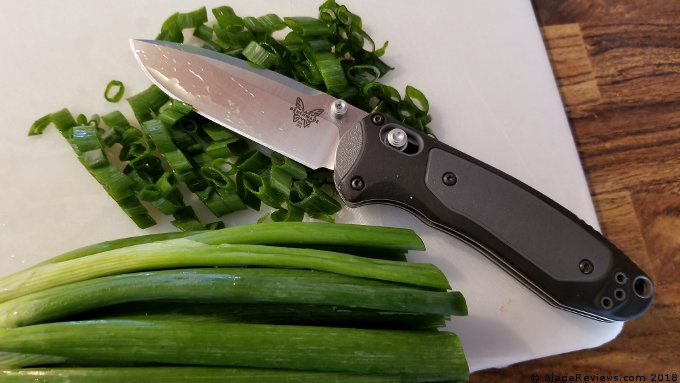
Buy the Benchmade Mini Bost at BladeHQ
This brings me to the Benchmade Mini Boost. I know about AXIS Locks, but I’d never handled an assisted one. So, when the company offered to send one over for review, I leapt at the opportunity. Here’s my review of the Mini Boost, a blade which just might change the way you think about spring-fired knives.
General Dimensions and Blade Details
As its name would indicate, this is the compact version of Benchmade’s USA-made Boost design. It sheds nearly an inch and a half of its predecessor’s length, now reaching a modest 7.18-inches open. Blade span has been reduced from 3.7-inches to 3.11, while slimming the stock from 0.12-inches to a demure 0.10. The CMP-S30V steel remains the same, as does its drop point, flat ground nature. Last is the weight, plunging from 4.59-ounces to 3.31.
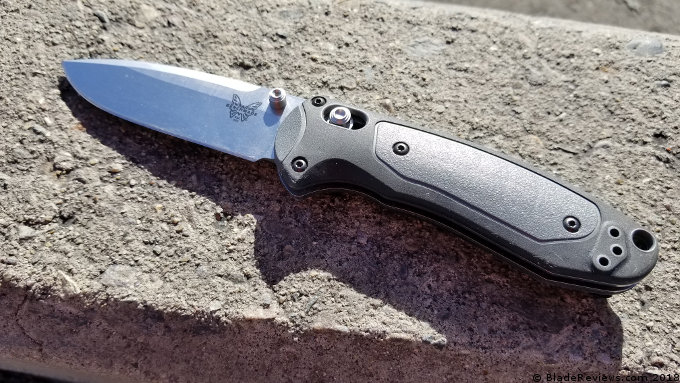
Enough numbers. Let’s flick the thumb stud, fire the AXIS Assist, and get to business.
As you can see from the cutting board photos, the Boost’s thin blade is an excellent slicer. Despite its American roots, the knife proved invaluable in the preparation of homemade General Tso’s Chicken. I had no trouble producing finely chopped pieces of ginger, garlic, and green onion. It proved equally capable in other daily chores, breezing through bags of dogfood and those annoying boxes for the toner cartridges at work.
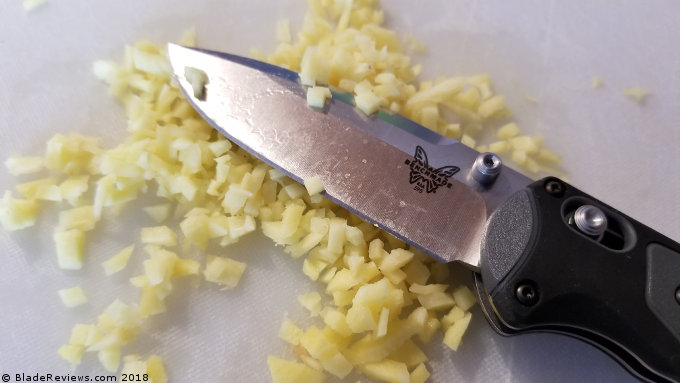
This does bring up something of a sore spot. When you use things, they tend to get dirty. I like to maintain my tools, which usually involves some form of disassembly and cleaning. The Mini Boost, however, will get no such treatment from me. AXIS locks are fiddly to take down in the first place, but add in what I assume is some form of torsion bar or coil setup and, man, I don’t need that kind of frustration in my life. The bronze washers are easily accessible, and a periodic application of oil may be all you need to keep it firing reliably.
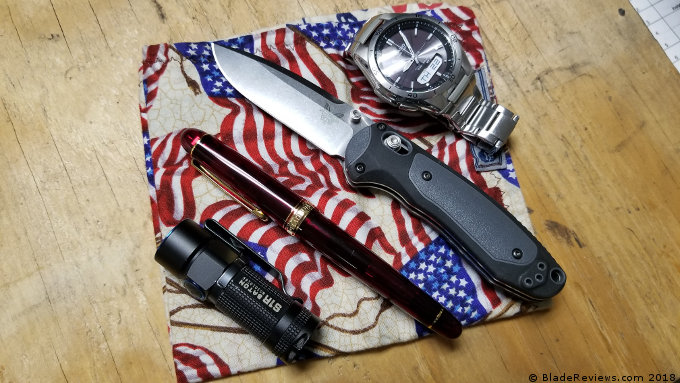
Speaking of reliability, I must have picked a good time to start reviewing Benchmades. While I’ve heard and read many complaints about their production and quality control, each of the three blades I’ve handled had zero problems. Maybe they’re closely monitoring the reviews samples, but I have nothing negative to report.
Handle, Ergonomics, and Pocket Clip
First impressions count for a lot, but they can also be deceiving. Take the Mini Boost’s width, for instance. My immediate in-hand reaction was, “Wow, this thing is thick.” And it is: 0.63-inches from a statistical standpoint. But take a look at this side-by-side comparison with the Spyderco Native 5.
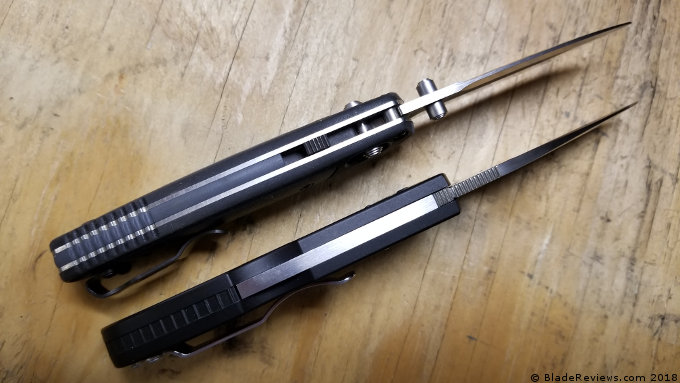
See that? The spines are pretty much identical, though the Boost’s sides swell out a bit further. In the pocket, this width is surprisingly comfortable. Part of this is due to its excellent deep-carry clip. The knife rides low in the back of my pocket, where its girth actually puffs out the seam and makes the rest of my tools more accessible. I prefer thinner knives, sure, but this slightly wide feel also helps with grip. The polymer scales are a perfect pairing, though they can accumulate a bit of pocket grit. Still, I consider this to be an acceptable hazard for a work-first blade.
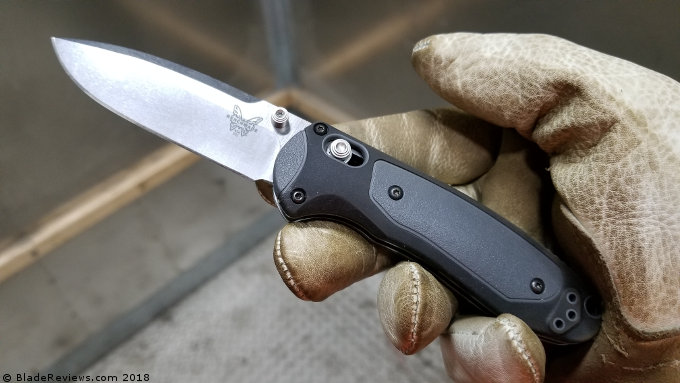
Let’s revisit the assist. Because of its sensitive thumb-stud deployment, Benchmade has included a safety switch above the AXIS Lock. This sends a piece of metal sliding into the mechanism, preventing the knife from accidentally deploying in your pocket. While I applaud their prudence in including this safety measure, it does cut down on some of the quick-fire appeal of an assisted blade. It leaves me wondering if assists and AXIS Locks are really meant to go together. It works, but the process definitely takes some getting used to. And while you certainly can carry it with the safety retracted, I was never quite comfortable with the idea of a loaded blade in my pocket.
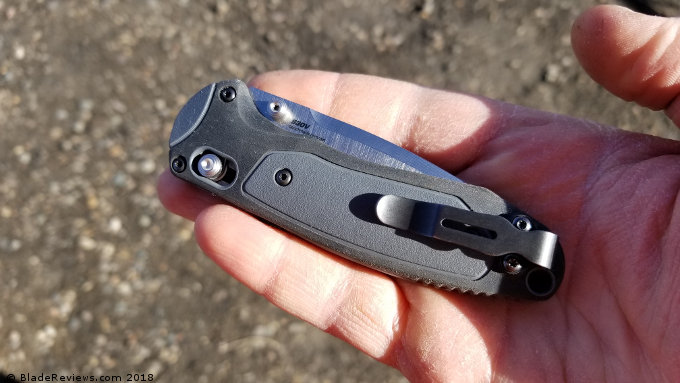
That being said, management of the AXIS Assist quickly becomes second nature. I carried this blade for nearly a month before completing the review, during which time I grew to appreciate both its deployment quirks and slicing prowess. One-handed closing is tricky, sure. But I kept fidgeting with it, over and over, just for the satisfying SNAKT noise of the blade leaping into place. For all its added complication over something like the Kershaw SpeedSafe, this assist is much more fun.
Benchmade Mini Boost Review – Final Thoughts
Let’s close with a thought experiment. Imagine you’re working a manual labor job in a dusty, grimy environment. Would you prefer a slick-firing folder running on ball bearings or an easy-opening blade sandwiched between phosphor bronze washers? For me, the answer is simple – Assist all the way. Because, sweet as that bearing action may be, it’s only a matter of time before job site gunk finds its way into the action. The solid washers and spring will run faster, longer, and more reliably in most hard-use situations.
As such, I consider the Mini Boost to be a solid argument for the existence of assisted knives. This, along with the Zero Tolerance 0566, is a solid example of spring-fired excellence. Yes, it’s trickier to maintain. But when it comes to down and dirty work, most of the calloused-handed folks I know prefer a blade with fast-deploy capability. I can’t tell you how many Kershaw Leeks and Ozark Trail folders I’ve seen peaking above the pockets of coveralls and dusty jeans.
In the end, the Boost proved to be a perfectly acceptable single-solution knife. It carries easily, cuts like crazy, and holds a decent edge. I’m still perplexed by the sudden resurgence of S30V, and I’d certainly prefer a better steel at this price point. But aside from the S30 and its pudgy width, there’s not a lot to dislike here. While I still prefer the mechanical precision of a dialed in detent, I’m also not the sort of hard user who cuts through boxes and bags all day. If that’s you, then consider checking out the Benchmade Mini Boost.
I recommend purchasing the Benchmade Mini Boost at Amazon or BladeHQ.
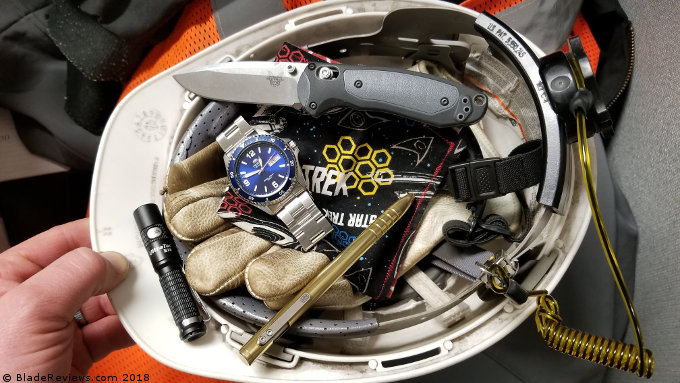

Benchmade has quality control issues. When I purchased my Mini Boost from Bass ProShop, the blade was not centered in the handle when closed. I went back and got another one, and this time when I got it home, I found the blade wasn’t very sharp (paper tore when I attempted to slice it). So, I decided to use Benchmade’s LifeSharp knife sharpening service (a lifetime warranty to sharpen any knife. ($15 to send it to them via UPS).
I got the knife back and it was no sharper than when I sent it a month earlier. Oh, well, I’ll have to sharpen the blade myself.
Bottom line: This company selling “premium knifes” at premium prices has quality control issues.